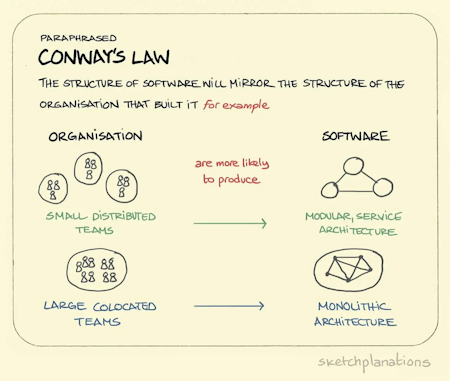Conway's Law
Teams design systems that mirror their communication structure.
"Any organization that designs a system will produce a design whose structure is a copy of the organization's communication structure." 1

The way teams and departments communicate, collaborate, and structure themselves has a direct influence on the systems, products, and processes they build. This observation, first formalized by Melvin Conway in 1967, reveals a persistent truth in software development: organizational boundaries and communication patterns become embedded in the architecture of the solutions produced. If two teams build parts of an application separately, their system will likely consist of two disjointed components, often introducing dependencies, coordination overhead, and structural inefficiencies.
Agile teams are designed to be cross-functional, autonomous, and aligned around customer value. But when an organization's structure enforces silos, such as distinct departments for development, testing, and operations, the systems built by those teams will mirror those separations. The result is often fragmented architecture, delayed feedback loops, and reduced collaboration. To create cohesive, responsive systems, Agile organizations must be intentional about aligning team design with their desired flow of work.
Scenario
A fintech company begins a digital transformation initiative, forming several Agile Release Trains under SAFe. However, the organizational structure remains unchanged: teams are still grouped under legacy functional departments like Frontend, Backend, Data, Security, and QA. Here's what unfolds:
- Backend and Frontend teams must negotiate every API change during PI Planning.
- Security reviews become a bottleneck late in each iteration, often blocking releases.
- QA lacks context on business goals, focusing on technical correctness over user experience.
- Product Owners are overburdened with cross-team coordination rather than strategic prioritization.
Despite high activity and regular events, customer feedback loops are delayed and quality suffers. The product mirrors the organizational gridlock.
Ways to Mitigate:
Agile organizations must intentionally structure themselves to reflect the product and customer journeys they wish to support. This requires rethinking team topology, communication channels, and architectural patterns.
- Redesign teams to match product and domain boundaries:
- Form value-aligned, cross-functional teams with autonomy over features or services.
- Align each team with a distinct user journey or business capability.
- Adopt modular, team-friendly architectures:
- Promote microservices or service-oriented architectures that support team independence.
- Encourage shared architectural ownership and minimize centralized gatekeeping.
- Use Team Topologies to map interactions:
- Classify team types (e.g., Stream-Aligned, Enabling, Complicated Subsystem, Platform) and define their interaction modes.
- Regularly inspect and adapt communication pathways based on delivery friction.
- Create shared goals and shared artifacts:
- Use Objectives and Key Results (OKRs) or Product Goal cascades to align effort.
- Encourage joint Backlog Refinement and shared Definition of Done across teams.
- Develop architectural leadership within teams:
- Invest in T-shaped skill development and architectural literacy.
- Move from "architects as reviewers" to "architects as enablers".
Conclusion:
Conway's Law reminds us that system architecture is not just a technical concern, it is a reflection of human relationships, incentives, and structures. Agile methods seek to decentralize control and bring work closer to the people doing it, yet without organizational alignment, the systems we build will entrench the very silos we aim to dissolve. Agile leaders must act as organizational architects, reshaping communication pathways and team boundaries to unlock product agility and responsiveness.
Key Takeaways
- Team and communication structures shape system architecture.
- Agile teams need to be designed for flow, not legacy reporting lines.
- Microservices and modular architectures support team independence.
- Team Topologies offer a practical model for rethinking organizational design.
- Organizational agility requires continuous inspection of both process and structure.
Summary
Conway's Law offers a powerful lens to examine why Agile transformations stall despite best practices. It reveals that what gets built reflects how people talk, plan, and collaborate. By designing team structures that align with customer value and architectural boundaries, Agile organizations can reduce complexity, accelerate delivery, and foster innovation. Understanding and addressing Conway's Law is not just a technical necessity, it is a strategic imperative for any Agile enterprise.